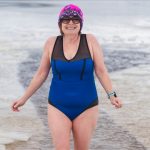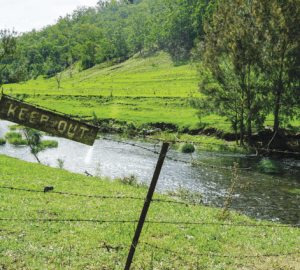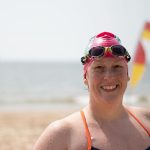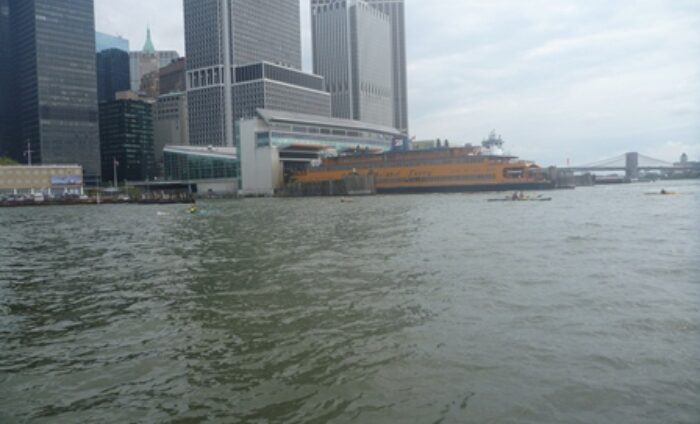
Jim Boucher’s 2012 Ederle Swim
Regular long distance swim Jim Boucher sent us this report of his recent swim from the southern tip of Manhattan through New York Harbour, under the Verrazano-Narrows Bridge and onto Sandy Hook, New Jersey. The 17.5 mile swim is organised by NYC Swim and passes such landmarks as the Statue of Liberty, Governors Island and the beaches of Staten Island. This is what he says:
It’s hard to believe so few have heard of Gertrude Ederle. Aged 23 she was the first woman to swim the English Channel, in 1926, in an era when the possibility or even appropriateness of women swimming the Channel was doubted. A one-time holder of the 100m Freestyle World Record (1:12.8 in 1923), the story of her swim into destiny is brilliantly described by Gavin Mortimer in his book “The Great Swim”.
The connection between the today’s race and Gertrude Ederle is that she swam the course as part of her training for the Channel. The race was first organised in 2006 by NYC Swim, but it was later in the season and competitors had to endure really cold and challenging conditions. 2012 saw the race moved to August and the organisers had high expectations that 17 solo-ers and 5 two-person relays would complete within the allotted eight hours.
13 of the 17 soloers, and all the relayers, were US or Canada citizens. Of the remaining 4, one was Swedish, one from India with Anglo-Australian ancestry. Ellery McGowan and I were the UK’s only representatives.WeI had come across the race in preparatory skirmishes around entry to the 2011 round-Manhattan swim. Entry processes were much the same, ie complex and time-consuming, so don’t leave it late, if you want to have a go.
As a twice-successful English Channel swimmer, my acceptance was straightforward. Despite her record (age)-breaking swim in the Lake Zurich Marathon swim, Ellery’s ultimate acceptance was hard-earned. Those without Manhattan or Channel solos to their name had to submit training records to prove their fitness to finish the course and Ellery had had a long period of uncertainty which came to an end in early July with final confirmation of her entry.
A friend of Ellery’s New York-based son and daughter-in-law let us use a Lower Manhattan apartment for three days, giving us a base close to the start of the course. With New York enduring a heatwave in the previous months, our concern, and emphasised in NYC’s briefings, was the need to have enough water on board the support boats and to be able to keep feeds cool, unlike the classic “hot maxim” diet of English waters.
Each swimmer or relay was accompanied by one boat – a small sport cabin cruiser, normally used for deep sea fishing and pleasure trips – and a kayaker. The kayaker did the feeding whilst the boat would navigate and mix feeds. NYC allocated the kayaker and boat leaving the swimmer to organise their support crew. The day before the swim we took the ferry from Manhattan to Sandy Hook / Atlantic Highlands New Jersey, which gave us a great chance to see the course and to note landmarks. Oh and what a day it was, blue sky, strong sun, so much so that I was slightly sunburnt through my shirt. If the race was to be in similar conditions, it would be just fine……
Overnight storms had been replaced by constant heavy drizzle as we marshalled and registered at North Cove, Lower Manhattan. Just like the Lake Zurich Marathon Swim where you have to get to know your support boat, it was new faces all around – my support crew member Chris Rogers from NY Port Authority Police, my kayaker Brian Fox and Boat Skipper Mario (Quint as I renamed him). I was supposed to bunch up with the other soloers to head to the start on a RIB, but Quint had other ideas and we all got a chance to introduce ourselves. With hindsight, this seemed a better thing to do than sitting on the RIB.
We had time to discuss the details of the feeding approach. I even had time to brief them on my unbalanced freestyle technique, previously described by IMHOF Skipper Mike Oram as “the worst front crawl ever seen in the English Channel.” We agreed my stroke rate, not the aesthetics, would be more indicative of my physical state. Chris got it straight away, “Jim, so you swim in a “right-hook, jab right-hook, jab way?” That was precisely it, no worries thereafter.
Chris was just off his shift at JFK Airport, so had come straight to the boat with his pistol which he informed me would be used to speed me along if I lagged, or even to deal with any suspicious triangular fins. I found this heartening. After all, it was the New Jersey shore attacks in 1916 that apparently inspired one Peter Benchley to write his original novels about killer codfish, before he realised this only had limited credibility. So now we have our boat, we have Quint and we also have Brody. All it needed was Brian to have a fascination for Marine Biology….
Brian was exposed to the elements at this stage. The rain tried to stop several times but the sky was a topical fifty shades of grey. The only undulations were some rather erratic, but lumpy, waves that were caused by the tide and the ferries criss-crossing the area adjacent to the start. Unknown to me, Ellery’s kayaker Min Kim had already got their trip off to a bad start. To paraphrase the immortal lines “Min, you can get to Sandy Hook but you’re going to need a bigger kayak!” Poor Min, armed with the first three feeds, never looked that stable at the start and before he’d exited North Cove he capsized. A second kayaker was hastily brought into service in time for Ellery’s first feed and both then followed her all the way to Sandy Hook.
The start itself was bedlam, not really clear why, but after a few “have they – haven’t they” moments, the first wave including our own Ellery were off, heading for the corner of the Buttermilk Channel. This first stretch was probably only around 1000 yards but it was the hairiest section of the course. Any ferry coming into Lower Manhattan’s various piers would either cross or manoeuvre in this spot and it was not calm, either in the sea waves or, indeed in the airwaves where we could still hear the officials shouting to get others into line. I was in the third wave and was summoned into the water to swim to the start RIB, where I should have been all the time. In a matter of seconds we were off, the same lemming-like traverse of the stretch to Governor’s island. It wasn’t that difficult once we got going and a large tower was the target for that first phase.
I’d seen enough of the melee at the start and the Staten Island ferry performing the equivalent of a hand-brake turn, to be convinced that sightseeing could be postponed for 20 minutes. I was pleasantly surprised to see the tower getting larger and progress was noticeable, if not swift. It didn’t take long to get to the tower and once we got there, things started to calm down. Somewhere along the traverse we’d not only got alongside our kayakers, but the weather started to pick up too. There was a hint of sun breaking through as I settled into a steady path, breathing, as ever, to the right and having the chance to look at the various buildings on Governor’s Island. I don’t recall anything significant other than the speed at which we were passing. Very soon I was around the point where I’d reckoned a first feed would be taken at one hour. However we were well ahead of time and I swam on, carried by the now-ebbing tide. It was with some amazement that I neared the end of the Buttermilk Channel and had the first iconic sight of the swim. Breathing right I was looking at the Statue of Liberty, round the point of the island and at the far side of the harbour. An amazing sight, the sun picking out her features, even at a distance.
Not only was I delighted to have progressed about 2.5 miles, the sun had come out and the first feed stop was coming up. Most importantly I was sure we had better tidal help than forecast and I knew Ellery wouldn’t have any problem in meeting the various waypoint cut-off times which had been held up to us at the briefing. If we failed to meet three of them then we could be removed from the swim.
That first feed is always a key point in any marathon swim. It sets the pattern for the rest of the swim and gives you confidence or otherwise in your support team. The feed was delivered as if Brian had been doing it for decades. I’d asked the guys on the boat to make sure I cleared the entire bottle and from them on they wouldn’t let me leave a drop. Brian reeled the bottle in and I move on, keeping Brooklyn on my left.
The rest of the second hour was uneventful, it was becoming a glorious day and I stole a glance at the course ahead. The imposing, and beautiful, profile of the Verrazano Narrows suspension bridge loomed large beyond the end of the Brooklyn shoreline. Moreover, I could sense progress, most unlike an English Channel swim where the French coastline doesn’t really appear to come into sharp focus until one is very close to it. I guess the answer is that we were always close to the bridge. Located around seven miles from the start, I had planned to pass it between three and three and a half hours. Given the rate I was approaching it, I reckoned that it could be done in less than three.
At two hours I fed again and the bridge was looking majestic. The Saturday shipping was pretty well non-existent and with the sun high in the sky any contact with the crew on Catalina Kaybee was very much high-fives and whooping and a-hollering as they say out there. There was no problem with the feed of cold maxim, served up skilfully and watched like eagles by those on the boat. I couldn’t have asked for a better day and we moved on, driven along by a current that was strengthening by the minute. At this stage the next manoeuvre saw us being directed from the parallel course alongside Brooklyn and heading for the main channel, and then to cross it so we would be clear of shipping for the remainder of the course. As we passed a starboard channel buoy the eddy current it was creating picked me up so much that I stopped turning my arms and was able to body-surf for maybe 30 metres.
The banter continued with the boat and at 2.5 hours I was feeding within of the midpoint of the 1300m centre span of the bridge. The bridge seemed to run from one side of the sky to the other as I looked up at its double-decks, once the longest bridge in the world when it was built in 1964. In the build-up I’d thought it would be cool to swim a bit of backstroke and it was a great feeling to be able to do this, even if my backstroke is also not the prettiest.
The previous day’s ferry trip had enabled us to view the waypoints and landmarks of the course. When you look at a map of the Lower Bay, ie the sea beyond the bridge, you see a pair of small (un-named) islands on your right followed by a third sporting a small lighthouse. We had worked out the distances, reckoning that if the tide started to drop off as we cleared the bridge, we would need to be able to measure progress against a number of waypoints as there was still, believe it or not, at least nine miles to go from the bridge to the finish.
I was delighted to pass the first landmark fairly soon and, even with taking time to eye up the next waypoint, it was apparent we were still making great progress. I’d reckoned these three landmarks pointed the way to the first 3 miles and from there its about 5 miles to get into the shore area around Sandy Hook. The lighthouse, the third landmark, passed by quickly and, unbelievably I was into the last 5 mile stretch.
I guess I am experienced enough from a number of swims to know that the end is never easy, however straightforward the initial phases may be. Even if I was swimming cheerfully, feeding every half hour on maxim, I was reserving my euphoria for what surely had to be a period of slack or adversely flowing tides. The later waves of swimmers had, by this stage, caught up and passed those of us who’d started earlier and when I stopped to feed or look around there was an impressive flotilla of fishing / sport boats and kayakers, all bobbing along on a glistening sea under a blue sky.
There was another small lighthouse-topped island which we reckoned was about three miles from the finish. Not a modern lighthouse, but a little short fat quaint one. I’d named it “Cable Junction” – after Jaws II – and if you look at the picture its not that bad a match. We were undoubtedly slowing as the boats passed this landmark. The tide had to drop off, but at this stage the leading boats would have been starting to gather for the final run in to Sandy Hook. Young, fit and damnably fast swimmers were already up there, and I clearly wasn’t one of these. I could hear horns which I assumed were swimmers finishing but later I discovered these were warning to numerous speedboats coming out from jetties around Sandy Hook.
I chuckled as a passed Cable Junction. I had a near full cast for the movie. I had Quint on board. Alongside him Detective Brody was doing well with motivating and feed preparation and we were passing Cable Junction. No big fish thank goodness but not no fish. After all we were about to cross a fishing area where we’d expected to encounter more small boats. I didn’t encounter small boats at close quarter, but I occasionally felt little fishy mouths at my toes or fingers. Something(s) had been continually puzzling me as they slipped between my fingers on each stroke. Later I was to discover they were completely transparent little jellyfish, clearly non-stinging. Not unnerving, just a bit puzzling.
I had stuck to a feed regime of maxim all the way:- 1 hour, 2 hours then 30 minutes thereafter. At around three hours I supplemented the Maxim with a gel and then a bit of banana on the next feed to offset any electrolyte drop off. I had plenty of feeds on board, but really hoped to be on dry land before I had to pick and choose more carefully.
Once the tide stopped its main ebbing flow, it was expected we’d encounter a movement from right to left at Sandy Hook as the New Jersey coastline emptied. I was happy, crew looked fine and occasionally Chris would come out with “right hook, jab” to lighten the moment. After 4.5 hours the faster swimmers were now landing and there was a lot of excitement as boats jockeyed for position. I was aware of instructions being given to my escorts that we had to stay right to counteract the drift. Other boats didn’t seem to follow the instructions and didn’t seem to be having problems but all the while I was being directed west to the extent I could now see the Manhattan skyline on my right as I breathed. Somehow I didn’t lose my cool but I am sure I had 30 minutes of no progress fighting the tide. Quint and Chris had offered me a bet I’d be ashore in an hour or be called English but this wasn’t winnable.
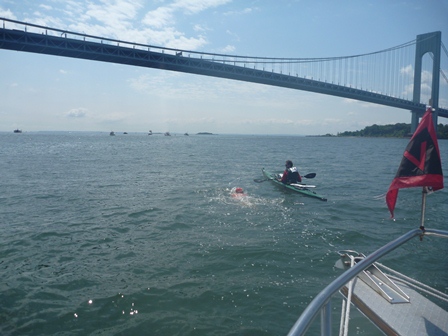
A large radio m st was a good target and we pushed for the beach. I didn’t skip feeds when we closed in, just because I reckoned that the tides were not helping and I would need all the energy if I was to get in quickly.
Brian told me I’d 50 yards to go but it was more like 150 in my view. Whatever it was, it wasn’t long before I was standing in the sand, in the sunshine in water nearing 80F after 5 hours 33 minutes. It was a glorious feeling to have made it. To not have had to get into the desperate moments of a Channel swim. I was quickly back in the boat and it was banter and tourism all the way, back through the Upper Bay to Manhattan, passing closer to the Statue of Liberty.
My only concern on the way back was for Ellery. I couldn’t see her at the finish, yet had no reason to fear she hadn’t or wouldn’t get there in due course. Back at the dock I waited anxiously for her to return. She arrived about an hour later and I was delighted to welcome her back. She looked fine and her crew of Angus and Renata had done a great job. They also had been directed westward at the finish but had still made it in a time of 6 hours 18 minutes.
Would I do it again? Probably not, but that would only be because I’ve done it. Having plucked up the courage to go afar for a marathon swim, I’d maybe want to look at others. Would I recommend it to others? Yes most certainly. In some ways the Ederle Swim is inferior to its bigger, brasher, more glamorous sister the Round-Manhattan Swim. But it’s by no means easier, in fact more challenging in some ways according to our organisers – Morty and Hannah who, along with all the helpers, boats and kayakers gave us both an amazing experience that day.




